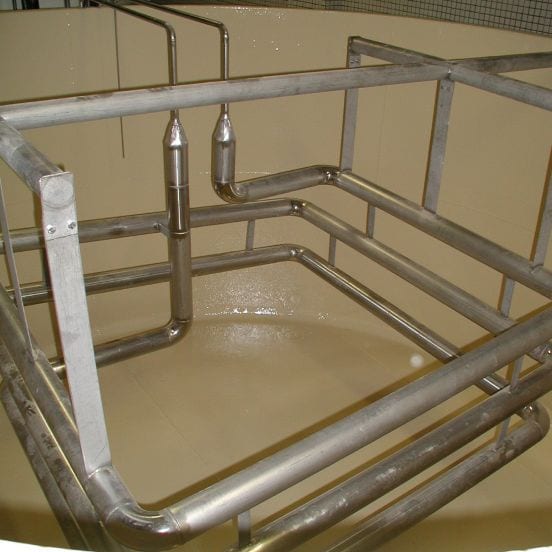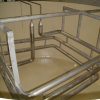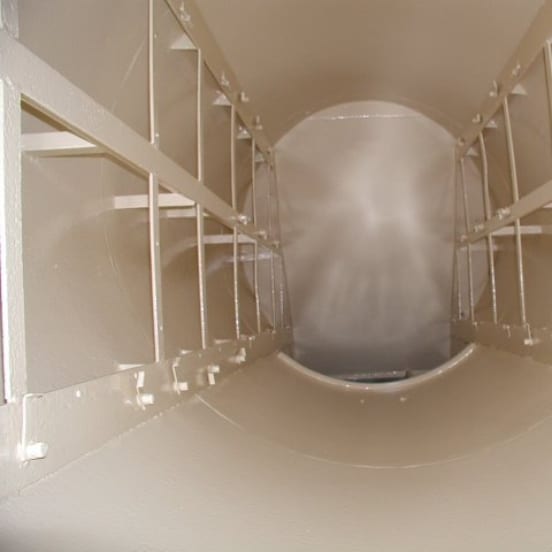Description
M-CHEM 101 – Chemical Resistant Epoxy Coating - Extended Cure
Is a surface tolerant, chemical resistant epoxy coating with a extended pot life.
The coating when cured has excellent resistance to wide range of commonly used chemicals and is typically used to protect concrete or steel structures.
M-CHEM 101 – Chemical Resistant Epoxy Coating – Extended Cure can be applied to manually prepared steel and is tolerant to damp and environments subject to condensation.
This two-component product is highly resistant to marine and industrial environments, buried conditions, ground water, effluents, salt water and a wide range of oils and chemicals.
Typical Uses
- As an Internal Pipe Lining
- lining for Fuel Storage Tanks
- Chemical Resistant Lining for Storage Tanks
- As a Chemical Resistant Floor Coating
- To Protect Bunds & Containment Area’s from Chemical Attack
Please contact us to discuss your project before purchasing this material to confirm suitability.
Application Guide
- All oil and grease must be removed from the surface using an appropriate cleaner such as MEK or similar type solvent.
- All surfaces must be abrasive blasted to ISO 8501/4 Standard SA2.5 (SSPC SP10/ NACE 2) minimum blast profile of 75 microns using an angular.
- Once blast cleaned the surface must be degreased and cleaned using MEK or similar type solvent.
- All surfaces must be coated before gingering or oxidation.
- All oil and grease must be removed from the surface using an appropriate cleaner such as MEK.
- All surfaces must be mechanically abraded using handheld grinders to ISO 8501/4 ST3 (SSPC SP3 ST3).
- Once abraded, the surface must be degreased and cleaned using MEK or similar type material.
- All surfaces must be repaired before gingering or oxidation occurs.
Existing Concrete
- If the concrete surface is contaminated pressure wash using clean water.
- Once the concrete is dry, lightly abrasive blast or scarify taking care not to expose the aggregate.
- Clean all dust and debris from the surface and take several moisture readings and prime with M-PRIME 100 – Low Viscosity Epoxy Concrete Primer or M-PRIME 104 – Damp Tolerant Concrete Primer dependent on the moisture readings obtained.
- Apply M-PRIME 100 or M-PRIME 104 at a target wet film of 150 microns and allow to cure before overcoating.
- For very porous surfaces a second coat of primer may be required.
New Concrete
- Allow new concrete to cure for a minimum of 21 days lightly abrasive blast or scarify to remove any surface laitance.
- Clean all dust and debris from the surface and take several moisture readings and prime with M-PRIME 100 – Low Viscosity Epoxy Concrete Primer or M-PRIME 104 – Damp Tolerant Concrete Primer dependent on the moisture readings obtained.
- Apply M-PRIME 100 or M-PRIME 104 at a target wet film of 150 microns and allow to cure before overcoating.
- For very porous surfaces a second coat of primer may be required.
Prior to mixing please ensure the following:
- The base component is at a temperature between 15-25°C.
- Do not apply the material when the ambient or substrate temperature is below 5°C.
- Transfer the contents of the Activator unit into the Base container.
- Using a low speed electric paddle mixer, mix the 2 components until a uniform material free of any streaks is achieved.
- Once mixing is complete, use the mixed paste as soon possible.
Use all mixed material within 20-25 minutes at 20°C.
Application – Brush & Roller
- Pour the mixed material into a paint kettle or paint tray (this will maximise the usable life).
- Stripe coat all edges, joints & corners.
- Once the stripe coat has cured and is capable of being overcoated apply a basecoat at a minimum wet film thickness 250 microns.
- Once the basecoat has cured sufficiently, approximately 10 hours at 20°C, apply a topcoat at a minimum wet film thickness of 250 microns.
Application – Spray
- Spray application should be carried out by airless spray using a 60:1 ratio pump with an attached hot water pump to heat the spray lines.
- The temperature of the spray lines should be kept around 25-35°C.
- Spray pressure of 3600psi and a tip size of 19-23 thou should be used.
- Use as short a line as possible to maintain product temperature (maximum 8 meters).
- Circulate the product for a short time to achieve a consistent temperature.
- Apply a basecoat to all surfaces at a minimum 250 microns wet film thickness.
- Once the basecoat has cured sufficiently, approximately 10 hours at 20°C. apply a topcoat to all surfaces at a minimum 250 microns wet film thickness.
| Appearance | Base Activator Mixed | Highly structured thixotropic liquid Amber liquid Thixotropic liquid |
| Mixing Ratio | By Weight By Volume | 3.5:1 2:1 |
| Density | Base Activator Mixed | 1.754 1.03 1.52 |
| Solids Content | 100% | |
| Sag Resistance | Nil at | 400 microns |
| Usable Life | 10°C 20°C 30°C | 120 minutes 60 minutes 30 minutes |
| Coverage | Basecoat applied at a minimum target film thickness of 250 microns: Topcoat applied at a minimum target film thickness of 250 microns: Finished, minimum target film thickness of 500 microns: | 4 sqm /ltr 4 sqm/ltr 2 sqm/ltr |
| Cure Times at 20°C | Minimum overcoating time Maximum overcoating time Water/ sea water immersion Chemical immersion | 10 hours 36 hours 3 days 7 days |
| Storage Life | Unopened and stored in dry conditions (15-30°C) | 5 years |
| Abrasion Resistance | Taber CS17 Wheels/1 Kg load | 138mg loss/1000 cycles 0.22cc loss/1000 cycles |
| Adhesion | Tensile Shear to ASTM D1002 on abrasive blasted mild steel with 75 micron profile | 194kg/cm² 2750psi |
| Impact Resistance | Tested to ASTM G14 | 2.0 Joules |
| Cathodic Disbondment | Tested to ISO 21809-3:2016 28 days, 1.5v, 3% NaCl | 23˚C 2.3mm 65˚C 5.1mm 95˚C 7.7mm |
| Compressive Strength | Tested to ASTM D 695 | 694kg/ cm² 9200psi |
| Corrosion Resistance | Tested to ASTM B117 | 5000 hours |
| Flexural Strength | Tested to ASTM D790 | 522kg/cm² 7400psi |
| Hardness | Shore D to ASTM D2240 | 80 |
| Heat Resistance | Suitable for use in immersed conditions at temperatures up to: Suitable for use in dry conditions at temperatures up to dependant on load: | 60°C 200°C |
Chemical Test Data
| Chemicals & Concentrations | Test Temperature | Chemicals & Concentrations | Test Temperature |
| Ammonia Brine Crude Oil De-ionised Water Diesel Ethanol Hydrochloric Acid up to 20% | 20˚C 40˚C 40˚C 30˚C 40˚C 20˚C 40˚C | Naphtha Nitrus Acid up to 10% Phosphoric Acid up to 30% Sodium Hydroxide up to 50% Sulphuric acid up to 20% | 40˚C 20˚C 40˚C 40˚C 40˚C |
Please contact us to discuss your project before purchasing this material to confirm suitability.











